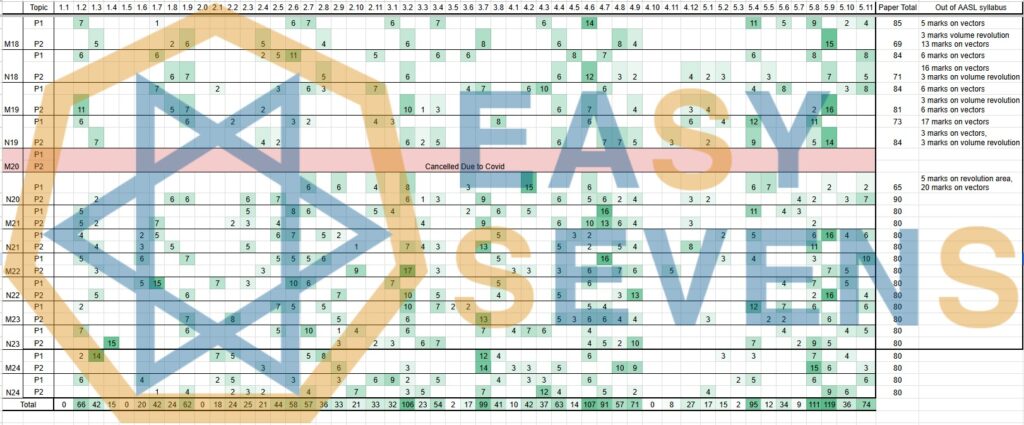As an IB graduate and IB Maths tutor for the past 5 years, I know firsthand how overwhelming it can be for IB students to tackle a complex research paper. And when that paper involves math, the challenge can feel even greater. That’s why in this article, I want to address the top 8 IB Math IA common mistakes that students make. It is imperative that you avoid these mistakes as the Math IA is a critical assignment that is worth 20% of your final math grade.
Through my tutoring experience, I have noticed that certain mistakes occur repeatedly, and I want to provide insights on how to avoid them. However, before delving into specifics, it’s important to acknowledge the anxiety that students feel when receiving feedback on their work. Having gone through the Math IA process myself, I understand the feeling of having your work scrutinized by teachers or tutors. But it’s crucial to recognize that receiving feedback is a normal part of the process, and even the best students get extensive feedback on their work. It’s essential to use feedback constructively to improve your work.
Mathematics is a technical subject that requires careful consideration of the words used. Misrepresenting a concept or misusing technical terms can significantly impact your grade. To avoid common mistakes, students must pay attention to details, read their work aloud, and utilize tools like Grammarly to identify small errors. Communication is also critical in the Math IA, as the exploration must be coherent, well-organized, concise, and comprehensive. In this article, we will highlight some of the common mistakes that students make when completing the Math IA and provide guidance on how to avoid them.
IB Math IA Common Mistake #1: Personal Engagement
One common mistake I often see in assignments is an overemphasis on personal engagement. While personal engagement is worth four marks, there are many misconceptions about how to use it to one’s advantage. It’s crucial to understand how to get personal engagement marks and not rely on cheesy background stories about one’s personal life, loosely related to the research question.
Personal engagement involves proactively showing how you engage in the assignment. This could include collecting your own data, doing something interesting, reflecting on the assignment, conducting preliminary experiments and improving on them, and using maths creatively. It’s essential to take the initiative and show effort in your assignment. You could also try creating a visual representation of your ideas, which could demonstrate your personal engagement.
The main differentiating factor between a three and a four in personal engagement is the wow factor. If your findings are genuinely interesting and add something to the world’s knowledge, that’s when you get the top marks. Avoid presenting basic or intuitive results that don’t mean much.
To succeed in personal engagement, you don’t have to write cheesy stories about your personal life or your relationship with linear regression. All you need to do is put in the effort and show that you have genuinely engaged with the assignment. The try-hard students who show that they tried hard and put effort into the assignment will score well in personal engagement.
Common Mistake #2 & #3: Improper Research Question and Aim
One of the most common mistakes in writing an IB Math IA is having a poorly formulated research question and not outlining the aim of the study properly. To create a well-crafted research question, you should include the variables you plan to measure and the mathematical analysis you intend to use to find the answers you seek. Your research question should neither be too broad nor too narrow, and you must try to strike the right balance between them. For example, a standard format for the research question could be, “What is the best shape for shampoo bottles to maximize their volume to surface area ratio?”
When you do not have a research question, it is essential to have a very specific aim that tells the examiner precisely what you want to do. The aim serves as a roadmap of what you intend to do in your method, and you must not add any extra background information. Your aim should be exactly what you are going to do, such as coding a simulation to demonstrate X, or determining the correlation between X and Y. Avoid using vague phrases like “relationship between them” and “building my understanding,” as they may not convey a clear sense of purpose.
To summarize, your aim should provide a specific roadmap of what you will do, while your research questions should be specific and describe the variables you will be discussing. If you will be doing multiple things, you can explain that in your aim, starting with what you plan to do, followed by what you will do next to achieve your goal. Remember to avoid providing any background information in your aim.
IB Math IA Common Mistake #4: Explanations and Interpretations
A fourth common mistake is forgetting to explain and interpret things. While there is a balance between explaining things and assuming the examiner has a basic understanding of what you are discussing, it is crucial to ensure that you explain and interpret adequately. Sometimes, students explain easy math that is already obvious, while other times, they forget to explain essential concepts. When writing your IB math IA, try to strike a balance and write to a level that is easily understandable by a friend without needing to explain every detail. By avoiding these common mistakes, you can create a well-written Math IA that demonstrates your understanding of the subject matter.
IB Math IA Common Mistake #5: Ugly Looking Equations
One of the most common mistakes that students make when writing their IB Math IA is failing to format their equations properly. It’s important to ensure that your equations look professional and are easy to read. Nice looking equations can make a significant difference in how your work is perceived by your teacher and examiner.
Here are some tips to help you get started:
- Use equation editors: Most word processors, including Google Docs and Word, have built-in equation editors that allow you to create mathematical expressions using various symbols and formatting options. These editors make it easy to create equations that are visually appealing and easy to read.
- Choose the right fonts: When creating equations, it’s important to use a font that is easy to read and looks professional. Avoid using fonts like Arial or Times New Roman for your equations, as they can be difficult to read and make your IA look unprofessional. Instead, use a different font for your equations and variables than your written text, even when they appear within a paragraph.
If you’re not familiar with using equation editors, it may take some practice to get the hang of it. To learn more about how to type equations nicely for your IB math IA, simply search for “how to use equations in Google Docs” or “how to use equations in Word,” and you’ll find plenty of helpful resources to guide you. While the Google Docs equation editor can be a bit challenging to use at first, with some practice, you’ll soon get the hang of it. Don’t be discouraged if it takes a few tries to create the perfect equation. You should experiment with different symbols, formatting options, and fonts until you find a style that works for you. By following these tips, you can make your equations look neat and professional, which will help improve the overall appearance of your math IA.
IB Math IA Common Mistake #6: Graphs
Graphing Mistakes
Another one of the most common mistakes in IB math IA is presenting poorly labeled or formatted graphs. This can negatively impact the presentation of your work and may also lead to the loss of marks. Here are some common mistakes to avoid when graphing your data:
- Improper labeling of axes and units: It is essential to properly label the x-axis and y-axis of your graph and include units. Additionally, uncertainties should be included, especially when measurements are involved. Ensure that you justify how you calculated the uncertainties.
- Inadequate title or caption: Your graph should have a detailed caption that explains what the graph represents and any relevant features. It should also include a title that is meaningful and accurately reflects the content of the graph.
- Inconsistent formatting: The formatting of your graph should be consistent throughout your IA. This includes keeping the same font, gridlines, and color scheme. This consistency ensures that your graphs are easy to read and understand.
- Poor use of space: Avoid leaving blank spaces on your graph. Ensure that your graph fits all the data points, and if necessary, adjust the x-axis or y-axis to accommodate your data.
Including Equations and R-Squared Values
In addition to graphing, it’s also essential to include equations and R-squared values in your IA. Ensure that you present the equations used to derive your results and include the R-squared value on your graph. This helps your readers understand your methodology and provides transparency to your analysis.
Explaining Calculations
When presenting calculations, ensure that you explain how you derived your results. Show examples of your calculations so that your readers can follow your thought process. Remember, the examiner can only see what’s in your IA, so ensure that you include all calculations.
Common Mistake #7: Improper Use of Mathematical Terminology
The next common mistake I often see in IB math IAs is the misuse of technical terms. It can be challenging to spot such mistakes, but it is crucial to avoid them. A lot of errors that I have seen involve a complete misuse of a technical term. For instance, using “causation” when you mean “correlation” or claiming that something is “significant” when you have not done a hypothesis test for it.
Several terms used in our daily language are mathematical terms that may sound strange when used outside of mathematics. Unless you are doing significance testing, which is a mathematical analytical technique in math, you should not use the word “significant” to talk about your results. The word “significant” has a specific meaning in math, and if you use it colloquially when discussing things, it can make it seem like you do not understand your stats correctly.
It is common to see IB math IAs where students throw in math terms without really understanding what they mean. They may do this to sound smart to the examiner, but it is not advisable. Only use a technical term if you genuinely know what it means. Misusing it can be more detrimental than not using it at all. Your math IA should be readable and not confusing to read. Use normal language and technical terms only when necessary.
IB Math IA Common Mistake #8: Poor Copying Technique
The final IB Math IA common mistake that students make when writing their IB Math IA is to use someone else’s methodology without fully understanding what the person did. They may try to apply a specific method of fitting a curve to their data, for instance, by copying the steps directly from another student’s IA. However, this approach can be problematic because the claims and assumptions that work in one person’s IA may not necessarily work in another’s.
While it’s okay to seek inspiration from other IA examples and build off their ideas, it’s important to do additional research on the subject to fully comprehend the methodology being used. Rather than simply copying the steps, take the time to understand the theory behind the methodology, and why it works in that particular context. This will help you to adapt the methodology to your own IA, and avoid making unnecessary errors.
For example, some students who have attempted to use the ordinary least squares method in their IA have encountered difficulties because they did not fully grasp what ordinary least squares was or how it was calculated. They attempted to fit curve without a clear understanding of the underlying concepts, resulting in errors in the calculations and explanations.
To avoid such pitfalls, it’s recommended that you invest ample time in researching and understanding the methodology that you plan to use in your IA. Spend time reading and trying to wrap your head around the concepts you want to explore. This will not only help you to avoid making mistakes but also enable you to score high in your IA.
Remember, while the IB does not expect you to come up with completely original ideas, it does expect you to demonstrate a strong understanding of the concepts you are exploring. So, take inspiration from others’ work, but make sure you understand the methodology behind it before attempting to replicate it.
Final Remarks
If you have any questions or need assistance with your IA, feel free to reach out to us. We offer IB Math tutoring and IA services, and we are happy to help. You can find more information about our services on our IB tutoring page. Good luck with your IAs!




